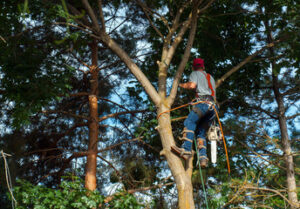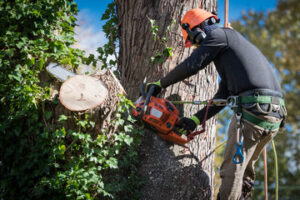Phoenix Tree Trimming is the practice of selectively removing branches to promote plant health, maintain a desired shape and size. It can also prevent branches from obstructing views or interfering with power lines.

Correct pruning enhances flower production and optimizes fruit yields. It reduces the risk of storm damage, improves overall appearance, increases air circulation, light penetration and minimizes pest problems.
A well-groomed landscape has a positive effect on the value of your home and property. Tree trimming and pruning is a crucial part of this process and can help you maintain the perfect shape of your trees, shrubs, and hedges while ensuring their health. This is done by removing the overgrown branches that prevent sunlight and moisture from reaching the rest of the plant.
In addition, trimming helps to enhance the visual appeal of your home and property. When properly performed, it creates an overall aesthetically pleasing look for the entire yard. Regular trimming can also promote healthy growth and encourage the development of new buds, which results in vibrant and lush foliage that is sure to impress anyone who visits your home or business.
Trees that are not properly trimmed can quickly become overgrown, leading to unsightly, unhealthy-looking landscapes. Overgrown branches can interfere with light penetration, reduce air circulation, and lead to structural failure or damage. In addition, if the excessive growth of a tree is left unchecked, it can lead to rot and pest infestations. Regular trimming and pruning can help to avoid this by preventing overgrowth, promoting healthy plant growth, and enhancing the overall aesthetics of your outdoor space.
Experts recommend performing routine pruning in late winter or early spring to reap the most benefits. During this time, the trees are dormant, which means that they will not be stressed and will have an easier time adjusting to the trimming. This technique also allows for a greater number of healthy buds to grow in the upcoming season, which is important for enhancing the beauty and longevity of your trees.
During a trim, experts will remove dead and diseased branches, as well as any limbs that are damaged or otherwise compromised. This not only improves the appearance of your landscape but can also prevent the spread of disease to other areas of the property. The removal of these unwanted limbs can also allow for better penetration of sunlight and air, which will trigger the production of more leaves, flowers, and fruits.
It Lifts Canopy
Tree trimming helps keep a healthy canopy by preventing lower branches from drooping and hanging. This is a common problem that can pose serious safety concerns, especially during stormy weather. Often, these drooping branches can cause damage to homes, cars, or other structures and also obstruct vision while driving on a busy road.
In addition, a tree with long lower branches can also interfere with the growth of other plants and grass on your property. A well-trained tree service can help you safely prune your trees without compromising their health or beauty.
Another reason to trim your trees is to promote air circulation through the canopy. This can reduce the conditions that are conducive to insect infestation and other problems. It can also enable more sunlight to penetrate the ground below, which is beneficial for the grass, flowers, and other vegetation in your yard.
This type of pruning is known as crown lifting or raising. It involves removing the low limbs of the tree to increase the height of its base. It is typically done on young and medium-aged trees to prevent them from growing into a large diameter at their base. Proactively pruning and shortening the lower limbs of young and medium-aged trees will stunt their growth and force more growth into the upper crown.
When you have your trees professionally trimmed, it will take less time to lift the canopy. The key is to use the right tools, and to know when to make the cuts. It is also important to leave a clean pruning “scar” and not to remove more than 25% of the total foliage at any one time. This will reduce stress and weight on the trunk and branches, which in turn can help to prevent tearing or damage.
A good rule of thumb is to keep your trees trimmed about twice per year, depending on the species and location of the tree. If you have younger trees that are still establishing their structure, it is a good idea to prune them more frequently, about every 2 to 3 years.
It Increases Photosynthesis
Trees are able to produce nutrients through photosynthesis, but this process is only possible if the leaves of the trees can reach the sunlight. This is where the importance of proper trimming comes in. During the pruning process, the extra and unwanted branches are removed. This gives the tree access to more sunlight and enables it to grow healthier.
Proper pruning also enhances the growth of higher branches. This can prevent the risk of falling limbs during storms, which could cause serious damage to property and injury to people. In addition, it is a good way to prevent a tree from blocking views or interfering with power lines.
There are different types of trimming methods, depending on the type and age of the tree. For example, crown thinning is commonly conducted on mature trees and involves removing specific live branches to reduce the overall canopy density. This increases air circulation and sunlight penetration while reducing stress on selected limbs from gravity, wind, snow, and ice.
Lastly, tree trimming also helps in preventing the loss of roots and the overall health of the tree. This is because a tree may lose its root structure if the branches are too thick, which can affect its ability to absorb water and nutrients from the soil. Moreover, the roots can die if they are hidden by the dense branches that can block the light, which decreases the photosynthetic activity of the tree.
In addition, regular tree trimming is a crucial step in protecting your home and property from pests and insects. Insects are attracted to moist and dense environments, which is why it is important to promote air circulation through the trimming and pruning process. In addition, identifying and removing diseased branches early can help reduce the spread of tree diseases. It is also advisable to report any diseases that you identify during the pruning and trimming process to a specialist. This will allow the specialist to treat the trees before the problem gets out of hand.
It Detects Diseases
Taking the time to trim your trees regularly allows you to notice when a tree starts to get unhealthy. This is important because diseases spread easily, and if they go unnoticed, they can quickly affect the entire canopy. A professional tree trimming service will identify and remove infected branches, halting the disease’s progression and ensuring the overall health of the tree.
For example, a disease called Powdery Mildew thrives in warm, humid conditions, and it is common for it to take hold in shady areas where the leaves stay damp for extended periods of time. When a branch is removed during a tree trimming service, it creates fresh wounds, which allow the disease to enter and infect the rest of the foliage. Powdery mildew isn’t dangerous, but it can reduce the amount of oxygen that a tree gets, making it difficult for it to grow and thrive.
Other symptoms of a disease that can be identified through regular pruning include discolored leaves, cankers on the bark, stunted growth, and premature leaf drop. If a tree is exhibiting these signs, it’s likely due to a number of factors, including improper watering, soil salinity, fertilization, and weather damage. However, a good tree trimming service will be able to detect the problem and recommend additional steps that can be taken to restore the health of the tree.
The benefits of a healthy tree are endless, and keeping your trees well-maintained is an excellent way to ensure their long-term health. The best time to perform routine pruning is in the winter or early spring, before new growth begins. However, it is important to remember that pruning should only be done by a trained and certified arborist. When performed incorrectly, it can cause more harm than good and may even lead to the death of the tree. Moreover, it is important to never climb large or tall trees without proper training and safety equipment. In addition, it is crucial to avoid performing any type of pruning within 10 feet of power lines.
